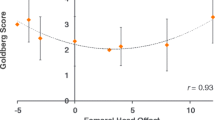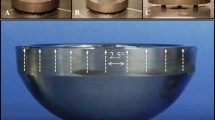Abstract
Background
The modular head taper junction has contributed to the success of total hip arthroplasty (THA) greatly. Taper corrosion and wear problems reported for large and extra-large metal-on-metal bearings as well as for bi-modular THA stems have cast doubt on the benefit of the taper interface. Presently, corrosion problems are being reported for nearly all kinds of artificial hip joints incorporating metal heads, questioning taper connections in general.
Questions/purposes
This study aimed to review the mechanical and electrochemical relationships that may lead to taper corrosion, which have been reported more commonly in recent literature, and to also review the contribution of patient characteristics and surgical techniques involved in taper assembly that may contribute to the problem.
Methods
The search criteria “(corrosion) AND (hip arthroplasty) AND (taper OR trunnion)” and “(hip arthroplasty) AND ((pseudotumor) OR (pseudo-tumor))” in PubMed and the JAAOS were used for the literature search. In addition, the arthroplasty registers were considered.
Results
Most studies acknowledge the multifactorial nature of the problem but concentrate their analysis on taper and implant design aspects, since this is the only factor that can be easily quantified. The sometimes conflicting results in the literature could be due to the fact that the other two decisive factors are not sufficiently considered: the loading situation in the patient and the assembly situation by the surgeon. All three factors together determine the fate of a taper junction in THA. There is no single reason as a main cause for taper corrosion. The combined “outcome” of these three factors has to be in a “safe range” to achieve a successful long-term taper fixation.
Conclusion
No, this is not the beginning of an epidemic. It is rather the consequence of disregarding known mechanical and electrochemical relationships, which in combination have recently caused a more frequent occurrence—and mainly reporting—of corrosion issues.






Similar content being viewed by others
References
Australian Orthopedic Association. Annual Report Hip and Knee Arthroplasty of the National Joint Registry 2015. aoanjrr.dmac.adelaide.edu.au/annual-reports-2015; 2013.
Australian Orthopedic Association. Metal on Metal Bearing Surface Total Conventional Hip Arthroplasty - Supplementary Report 2015. aoanjrr.dmac.adelaide.edu.au/annual-reports-2015; 2015.
Bartolozzi A, Black J. Chromium concentrations in serum, blood clot and urine from patients following total hip arthroplasty. Biomaterials. 1985;6(1):2–8.
Bergmann G, Graichen F, Rohlmann A et al. Realistic loads for testing hip implants. Biomed Mater Eng. 2010;20(2):65–75.
Bishop NE, Hothan A, Morlock MM. High friction moments in large hard-on-hard hip replacement bearings in conditions of poor lubrication. J Orthop Res. 2013;31(5):807–13.
Bishop NE, Waldow F, Morlock MM. Friction moments of large metal-on-metal hip joint bearings and other modern designs. Med Eng Phys. 2008;30(8):1057–64.
Bishop N, Witt F, Pourzal R et al. Wear patterns of taper connections in retrieved large diameter metal-on-metal bearings. J Orthop Res. 2013;31(7):1116–22.
Black J, Maitin EC, Gelman H, Morris DM. Serum concentrations of chromium, cobalt and nickel after total hip replacement: a six month study. Biomaterials. 1983;4(3):160–4.
Buente D, Huber G, Bishop N, Morlock M. Quantification of material loss from the neck piece taper junctions of a bimodular primary hip prosthesis. A retrieval study from 27 failed Rejuvenate bimodular hip arthroplasties. Bone Joint J. 2015;97-B(10):1350–7.
Chana R, Esposito C, Campbell PA, Walter WK, Walter WL. Mixing and matching causing taper wear: corrosion associated with pseudotumour formation. J Bone Joint Surg Br. 2012;94(2):281–6.
Cook RI, Render M, Woods DD. Gaps in the continuity of care and progress on patient safety. BMJ. 2000;320(7237):791–4.
Craig P, Bancroft G, Burton A, Collier S, Shaylor P, Sinha A. Raised levels of metal ions in the blood in patients who have undergone uncemented metal-on-polyethylene Trident-Accolade total hip replacement. Bone Joint J. 2014;96-B(1):43–7.
Del BC, Teeter MG, Tan SC, Howard JL, Lanting BA. Trunnionosis: Does Head Size Affect Fretting and Corrosion in Total Hip Arthroplasty? J Arthroplasty. 2016 March 18.
Del BC, Teeter MG, Tan SC, Lanting BA, Howard JL. Taperosis: Does head length affect fretting and corrosion in total hip arthroplasty? Bone Joint J. 2015;97-B(7):911–6.
Donaldson FE, Coburn JC, Siegel KL. Total hip arthroplasty head-neck contact mechanics: a stochastic investigation of key parameters. J Biomech. 2014;47(7):1634–41.
Garbuz DS, Tanzer M, Greidanus NV, Masri BA, Duncan CP. The John Charnley Award: Metal-on-metal hip resurfacing versus large-diameter head metal-on-metal total hip arthroplasty: a randomized clinical trial. Clin Orthop Relat Res. 2010;468(2):318–25.
Goldberg JR, Gilbert JL. In vitro corrosion testing of modular hip tapers. J Biomed Mater Res B Appl Biomater. 2003;64(2):78–93.
Goldberg JR, Gilbert JL, Jacobs JJ, Bauer TW, Paprosky W, Leurgans S. A multicenter retrieval study of the taper interfaces of modular hip prostheses. Clin Orthop Relat Res. 2002;(401):149–61.
Goyal N, Ho H, Fricka KB, Engh CA, Jr. Do you have to remove a corroded femoral stem? J Arthroplasty. 2014;29(9 Suppl):139–42.
Guhrs J, Krull A, Witt F, Morlock MM. The influence of stem taper re-use upon the failure load of ceramic heads. Med Eng Phys. 2015;37(6):545–52.
Haschke H, Jauch-Matt SY, Sellenschloh K, Huber G, Morlock MM. Assembly force and taper angle difference influence the relative motion at the stem-neck interface of bi-modular hip prostheses. Proc Inst Mech Eng H. 2016;230(7):690–9.
Hothi HS, Berber R, Whittaker RK, Blunn GW, Skinner JA, Hart AJ. The Relationship Between Cobalt/Chromium Ratios and the High Prevalence of Head-Stem Junction Corrosion in Metal-on-Metal Total Hip Arthroplasty. J Arthroplasty. 2016;31(5):1123–7.
Hothi HS, Matthies AK, Berber R, Whittaker RK, Skinner JA, Hart AJ. The Reliability of a Scoring System for Corrosion and Fretting, and Its Relationship to Material Loss of Tapered, Modular Junctions of Retrieved Hip Implants. J Arthroplasty. 2013 December 10.
Hutt J, Lavigne M, Lungu E, Belzile E, Morin F, Vendittoli PA. Comparison of Whole-Blood Metal Ion Levels Among Four Types of Large-Head, Metal-on-Metal Total Hip Arthroplasty Implants: A Concise Follow-up, at Five Years, of a Previous Report. J Bone Joint Surg Am. 2016;98(4):257–66.
Jauch SY, Coles LG, Ng LV, Miles AW, Gill HS. Low torque levels can initiate a removal of the passivation layer and cause fretting in modular hip stems. Med Eng Phys. 2014;36(9):1140–6.
Jauch SY, Huber G, Hoenig E, Baxmann M, Grupp TM, Morlock MM. Influence of material coupling and assembly condition on the magnitude of micromotion at the stemGÇôneck interface of a modular hip endoprosthesis. J Biomechanics. 2011;44(9):1747–51.
Jauch SY, Huber G, Sellenschloh K et al. Micromotions at the taper interface between stem and neck adapter of a bimodular hip prosthesis during activities of daily living. J Orthop Res. 2013;31(8):1165–71.
Jennings JM, Dennis DA, Yang CC. Corrosion of the Head-neck Junction After Total Hip Arthroplasty. Journal of the American Academy of Orthopedic Surgeons. 2016;24(6):349–56.
Koper M, Mathijsen N, van Ravensway Claasen H, Witt F, Morlock MVC. Severe wear and pseudotumor formation due to taper mismatch in a total hip artroplasty. JBJS Case Connect. 5. 8-4-2015.
Kurtz SM, Kocagoz SB, Hanzlik JA et al. Do Ceramic Femoral Heads Reduce Taper Fretting Corrosion in Hip Arthroplasty? A Retrieval Study. Clin Orthop Relat Res. 2013 June 13.
Lachiewicz PF, Heckman DS, Soileau ES, Mangla J, Martell JM. Femoral head size and wear of highly cross-linked polyethylene at 5 to 8 years. Clin Orthop Relat Res. 2009;467(12):3290–6.
Lavernia CJ, Baerga L, Barrack RL et al. The effects of blood and fat on Morse taper disassembly forces. Am J Orthop. (Belle Mead NJ) 2009;38(4):187–90.
Lavernia CJ, Iacobelli DA, Villa JM, Jones K, Gonzalez JL, Jones WK. Trunnion-Head Stresses in THA: Are Big Heads Trouble? J Arthroplasty. 2015;30(6):1085–8.
Learmonth ID, Young C, Rorabeck C. The operation of the century: total hip replacement. Lancet. 2007;370(9597):1508–19.
Lucas LC, Buchanan RA, Lemons JE. Investigations on the galvanic corrosion of multi-alloy total hip prostheses. J Biomed Mater Res. 1981;15(5):731–47.
Malchau H, Bragdon CR, Muratoglu OK. The stepwise introduction of innovation into orthopedic surgery: the next level of dilemmas. J Arthroplasty. 2011;26(6):825–31.
Morlock MM. The taper disaster - how could it happen? Hip Int. 2015;20:0.
National Joint Registry. 12th Annual Report for England, Wales, Northern Ireland and the Isle of Man. www.njrreports.org.uk; 2015.
Osman K, Panagiotidou AP, Khan M, Blunn G, Haddad FS. Corrosion at the head-neck interface of current designs of modular femoral components: essential questions and answers relating to corrosion in modular head-neck junctions. Bone Joint J. 2016;98-B(5):579–84.
Panagiotidou A, Meswania J, Hua J, Muirhead-Allwood S, Hart A, Blunn G. Enhanced wear and corrosion in modular tapers in total hip replacement is associated with the contact area and surface topography. J Orthop Res. 2013;31(12):2032–9.
Panagiotidou A, Meswania J, Osman K et al. The effect of frictional torque and bending moment on corrosion at the taper interface : an in vitro study. Bone Joint J. 2015;97-B(4):463–72.
Pennock AT, Schmidt AH, Bourgeault CA. Morse-type tapers: factors that may influence taper strength during total hip arthroplasty. J Arthroplasty. 2002;17(6):773–8.
Porter DA, Urban RM, Jacobs JJ, Gilbert JL, Rodriguez JA, Cooper HJ. Modern trunnions are more flexible: a mechanical analysis of THA taper designs. Clin Orthop Relat Res. 2014;472(12):3963–70.
Rehmer A, Bishop NE, Morlock MM. Influence of assembly procedure and material combination on the strength of the taper connection at the head-neck junction of modular hip endoprostheses. Clin Biomech. (Bristol, Avon) 2012;27(1):77–83.
Schafer R, Soltesz U, Bernard PF. Friction in hip-joint prostheses and its influence on the fixation of the artificial head. J Mater Sci Mater Med. 1998;9(12):687–90.
Svensson O, Mathiesen EB, Reinholt FP, Blomgren G. Formation of a fulminant soft-tissue pseudotumor after uncemented hip arthroplasty. A case report. J Bone Joint Surg Am. 1988;70(8):1238–42.
Tan SC, Lau AC, Del BC, Howard JL, Lanting BA, Teeter MG. Tribocorrosion: Ceramic and Oxidized Zirconium vs Cobalt-Chromium Heads in Total Hip Arthroplasty. J Arthroplasty. 2016 February 27.
Tan SC, Teeter MG, Del BC, Howard JL, Lanting BA. Effect of Taper Design on Trunnionosis in Metal on Polyethylene Total Hip Arthroplasty. J Arthroplasty. 2015;30(7):1269–72.
Tucker K, Pickford M, Newell C, Howard P, Hunt LP, Blom AW. Mixing of components from different manufacturers in total hip arthroplasty: prevalence and comparative outcomes. Acta Orthop. 2015;86(6):671–7.
Werner PH, Ettema HB, Witt F, Morlock MM, Verheyen CC. Basic principles and uniform terminology for the head-neck junction in hip replacement. Hip Int. 2015;25(2):115–9.
White PB, Meftah M, Ranawat AS, Ranawat CS. A Comparison of Blood Metal Ions in Total Hip Arthroplasty Using Metal and Ceramic Heads. J Arthroplasty. 2016 March 23.
Witt F, Guhrs J, Morlock MM, Bishop NE. Quantification of the Contact Area at the Head-Stem Taper Interface of Modular Hip Prostheses. PLoS One. 2015;10(8):e0135517.
Wuttke V, Witte H, Kempf K, Oberbach T, Delfosse D. Influence of various types of damage on the fracture strength of ceramic femoral heads. Biomed Tech. (Berl) 2011;56(6):333–9.
Author information
Authors and Affiliations
Corresponding author
Ethics declarations
Conflict of Interest
Dennis Bünte, Dipl.-Ing., and Julian Gührs, MSc have declared that they have no conflict of interest. Michael Morlock, PhD, reports personal fees from DePuy Synthes, Zimmer, Ceramtec, Smith & Nephew, Aesculap and Corin; grants from DePuy Synthes and Ceramtec outside the work. Nicholas Bishop, PhD, reports personal fees from DePuy Synthes outside the work.
Human/Animal Rights
This article does not contain any studies with human or animal subjects performed by the any of the authors.
Informed Consent
N/A
Required Author Forms
Disclosure forms provided by the authors are available with the online version of this article.
Electronic supplementary material
Below is the link to the electronic supplementary material.
ESM 1
(PDF 1,225 kb)
Rights and permissions
About this article
Cite this article
Morlock, M., Bünte, D., Gührs, J. et al. Corrosion of the Head-Stem Taper Junction—Are We on the Verge of an Epidemic?. HSS Jrnl 13, 42–49 (2017). https://doi.org/10.1007/s11420-016-9526-4
Received:
Accepted:
Published:
Issue Date:
DOI: https://doi.org/10.1007/s11420-016-9526-4




